Corporate Finance Assignment: CWC Project Evaluation and Analysis
VerifiedAdded on 2021/04/21
|9
|1061
|26
Homework Assignment
AI Summary
This assignment analyzes a corporate finance problem for CWC, evaluating a potential bottled water project. It begins with calculating the value of shares and determining the Weighted Average Cost of Capital (WACC) using the cost of equity and the cost of bonds. The solution then assesses the project's feasibility by calculating depreciation and Net Present Value (NPV) under different scenarios (current, best-case, and worst-case), concluding that the project is only acceptable under the best-case scenario. The document also discusses the importance of NPV as a tool for financial analysts, emphasizing the consideration of the time value of money and the need for analysts to gather information from management regarding their preferences before making recommendations. Finally, the assignment references several sources that support the calculations and conclusions.
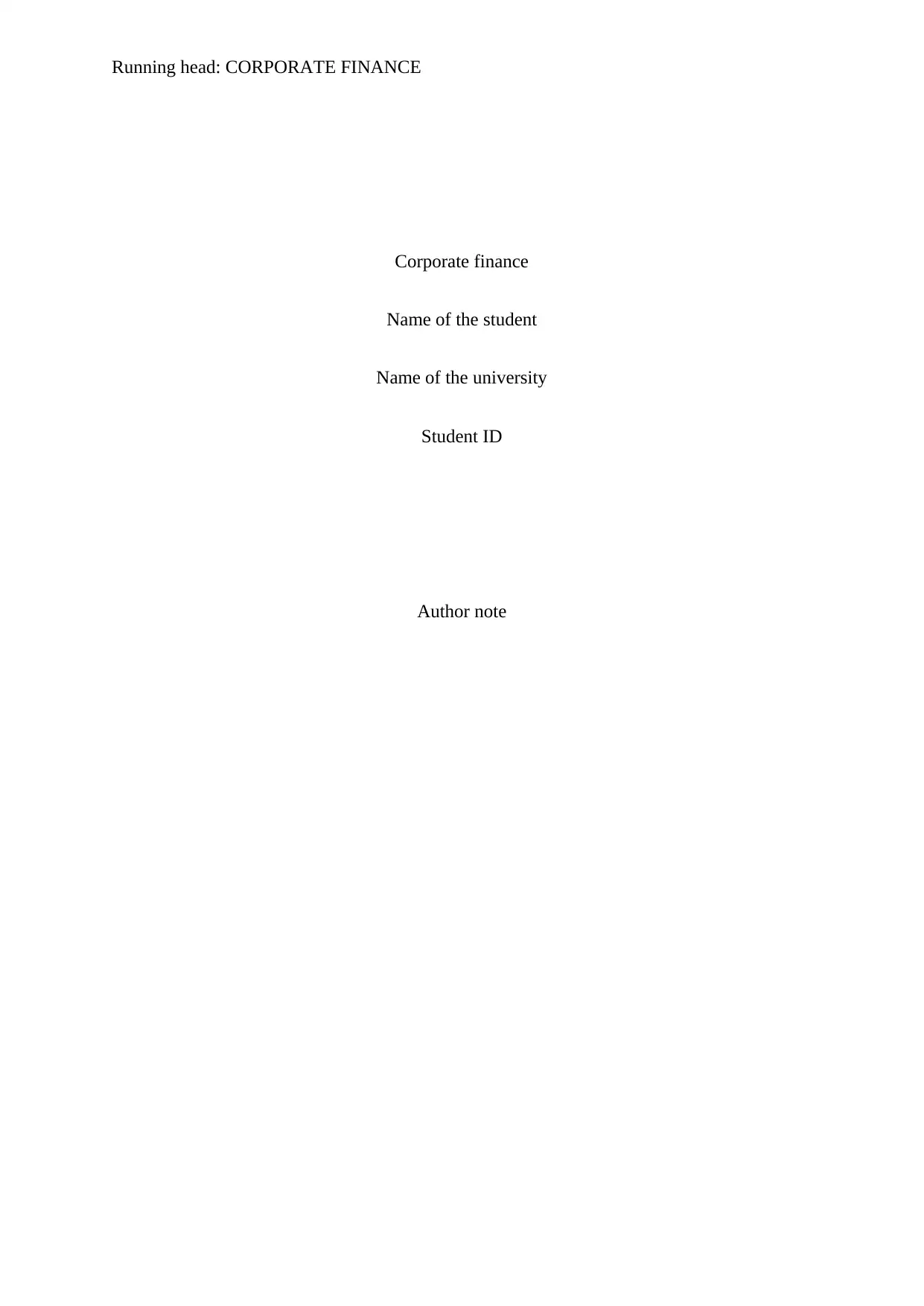
Running head: CORPORATE FINANCE
Corporate finance
Name of the student
Name of the university
Student ID
Author note
Corporate finance
Name of the student
Name of the university
Student ID
Author note
Paraphrase This Document
Need a fresh take? Get an instant paraphrase of this document with our AI Paraphraser
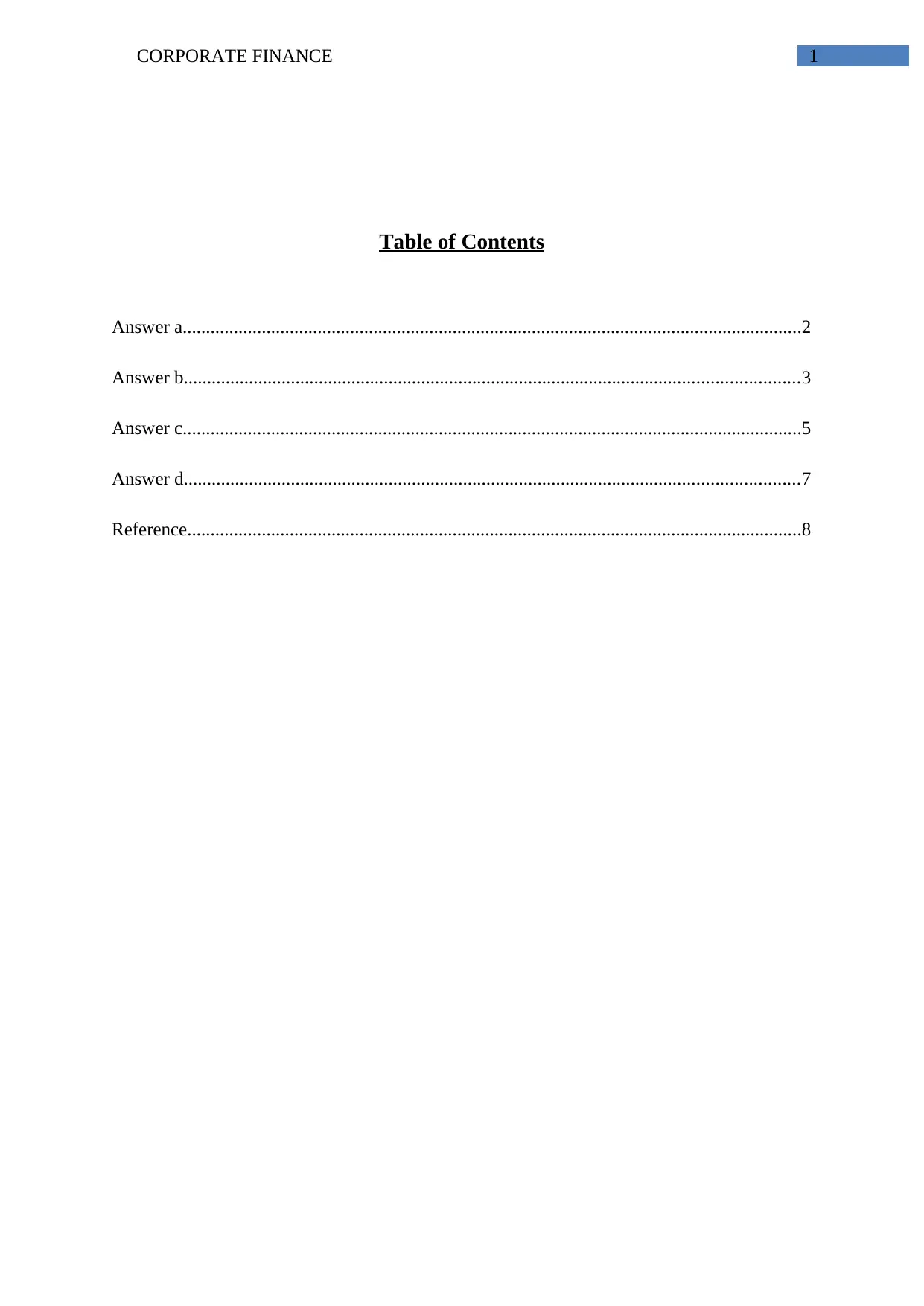
1CORPORATE FINANCE
Table of Contents
Answer a.....................................................................................................................................2
Answer b....................................................................................................................................3
Answer c.....................................................................................................................................5
Answer d....................................................................................................................................7
Reference....................................................................................................................................8
Table of Contents
Answer a.....................................................................................................................................2
Answer b....................................................................................................................................3
Answer c.....................................................................................................................................5
Answer d....................................................................................................................................7
Reference....................................................................................................................................8
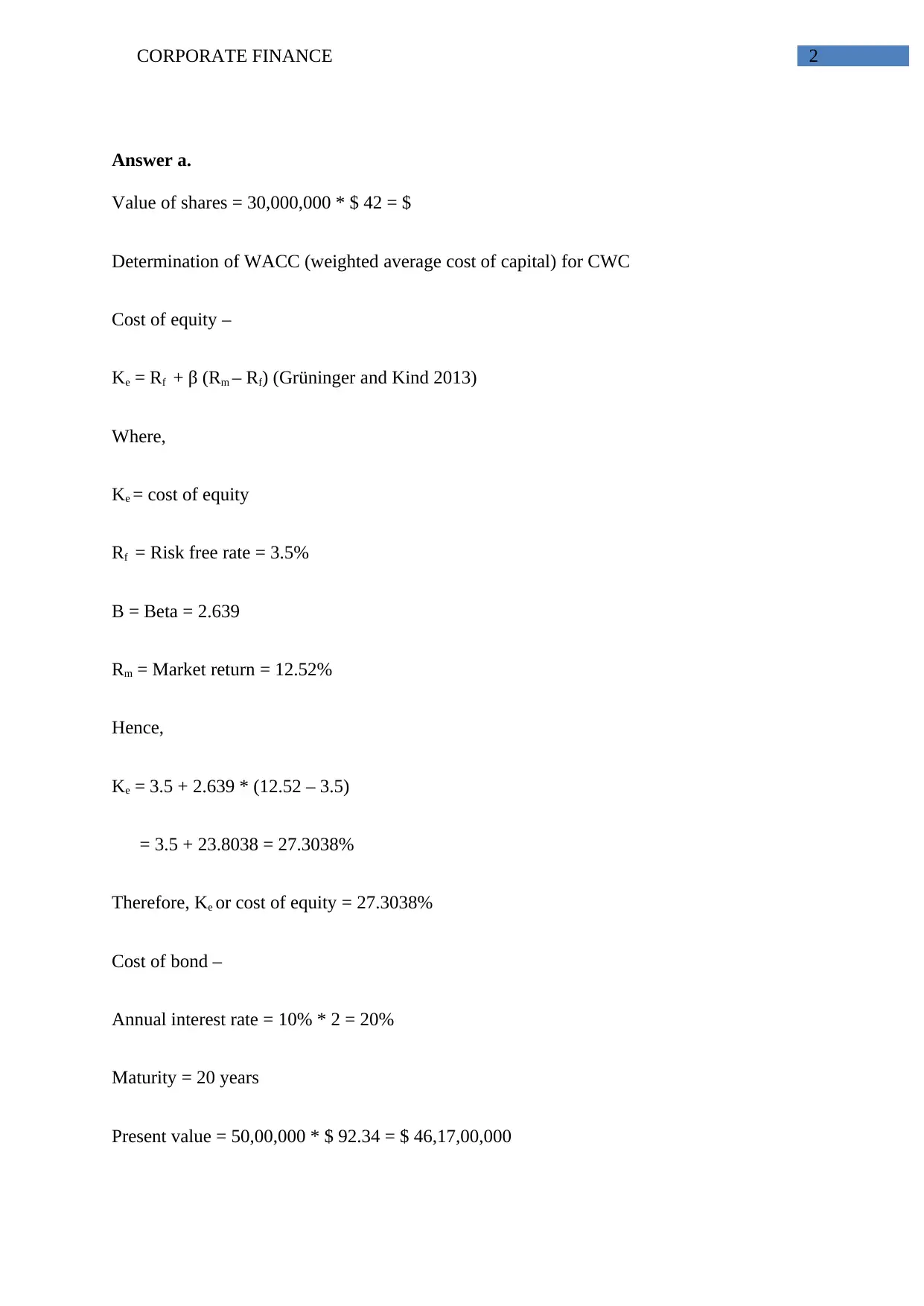
2CORPORATE FINANCE
Answer a.
Value of shares = 30,000,000 * $ 42 = $
Determination of WACC (weighted average cost of capital) for CWC
Cost of equity –
Ke = Rf + β (Rm – Rf) (Grüninger and Kind 2013)
Where,
Ke = cost of equity
Rf = Risk free rate = 3.5%
Β = Beta = 2.639
Rm = Market return = 12.52%
Hence,
Ke = 3.5 + 2.639 * (12.52 – 3.5)
= 3.5 + 23.8038 = 27.3038%
Therefore, Ke or cost of equity = 27.3038%
Cost of bond –
Annual interest rate = 10% * 2 = 20%
Maturity = 20 years
Present value = 50,00,000 * $ 92.34 = $ 46,17,00,000
Answer a.
Value of shares = 30,000,000 * $ 42 = $
Determination of WACC (weighted average cost of capital) for CWC
Cost of equity –
Ke = Rf + β (Rm – Rf) (Grüninger and Kind 2013)
Where,
Ke = cost of equity
Rf = Risk free rate = 3.5%
Β = Beta = 2.639
Rm = Market return = 12.52%
Hence,
Ke = 3.5 + 2.639 * (12.52 – 3.5)
= 3.5 + 23.8038 = 27.3038%
Therefore, Ke or cost of equity = 27.3038%
Cost of bond –
Annual interest rate = 10% * 2 = 20%
Maturity = 20 years
Present value = 50,00,000 * $ 92.34 = $ 46,17,00,000
⊘ This is a preview!⊘
Do you want full access?
Subscribe today to unlock all pages.

Trusted by 1+ million students worldwide
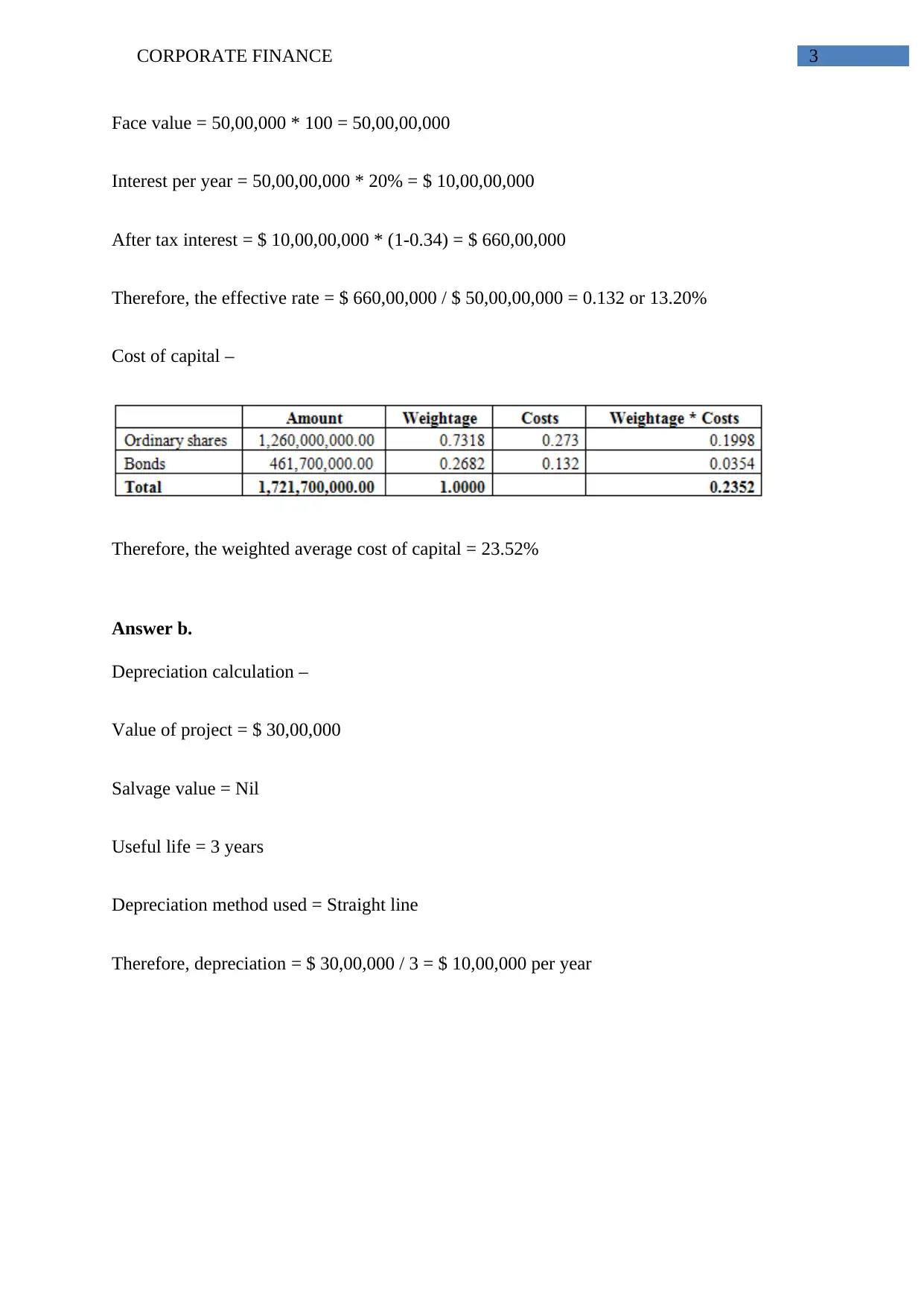
3CORPORATE FINANCE
Face value = 50,00,000 * 100 = 50,00,00,000
Interest per year = 50,00,00,000 * 20% = $ 10,00,00,000
After tax interest = $ 10,00,00,000 * (1-0.34) = $ 660,00,000
Therefore, the effective rate = $ 660,00,000 / $ 50,00,00,000 = 0.132 or 13.20%
Cost of capital –
Therefore, the weighted average cost of capital = 23.52%
Answer b.
Depreciation calculation –
Value of project = $ 30,00,000
Salvage value = Nil
Useful life = 3 years
Depreciation method used = Straight line
Therefore, depreciation = $ 30,00,000 / 3 = $ 10,00,000 per year
Face value = 50,00,000 * 100 = 50,00,00,000
Interest per year = 50,00,00,000 * 20% = $ 10,00,00,000
After tax interest = $ 10,00,00,000 * (1-0.34) = $ 660,00,000
Therefore, the effective rate = $ 660,00,000 / $ 50,00,00,000 = 0.132 or 13.20%
Cost of capital –
Therefore, the weighted average cost of capital = 23.52%
Answer b.
Depreciation calculation –
Value of project = $ 30,00,000
Salvage value = Nil
Useful life = 3 years
Depreciation method used = Straight line
Therefore, depreciation = $ 30,00,000 / 3 = $ 10,00,000 per year
Paraphrase This Document
Need a fresh take? Get an instant paraphrase of this document with our AI Paraphraser
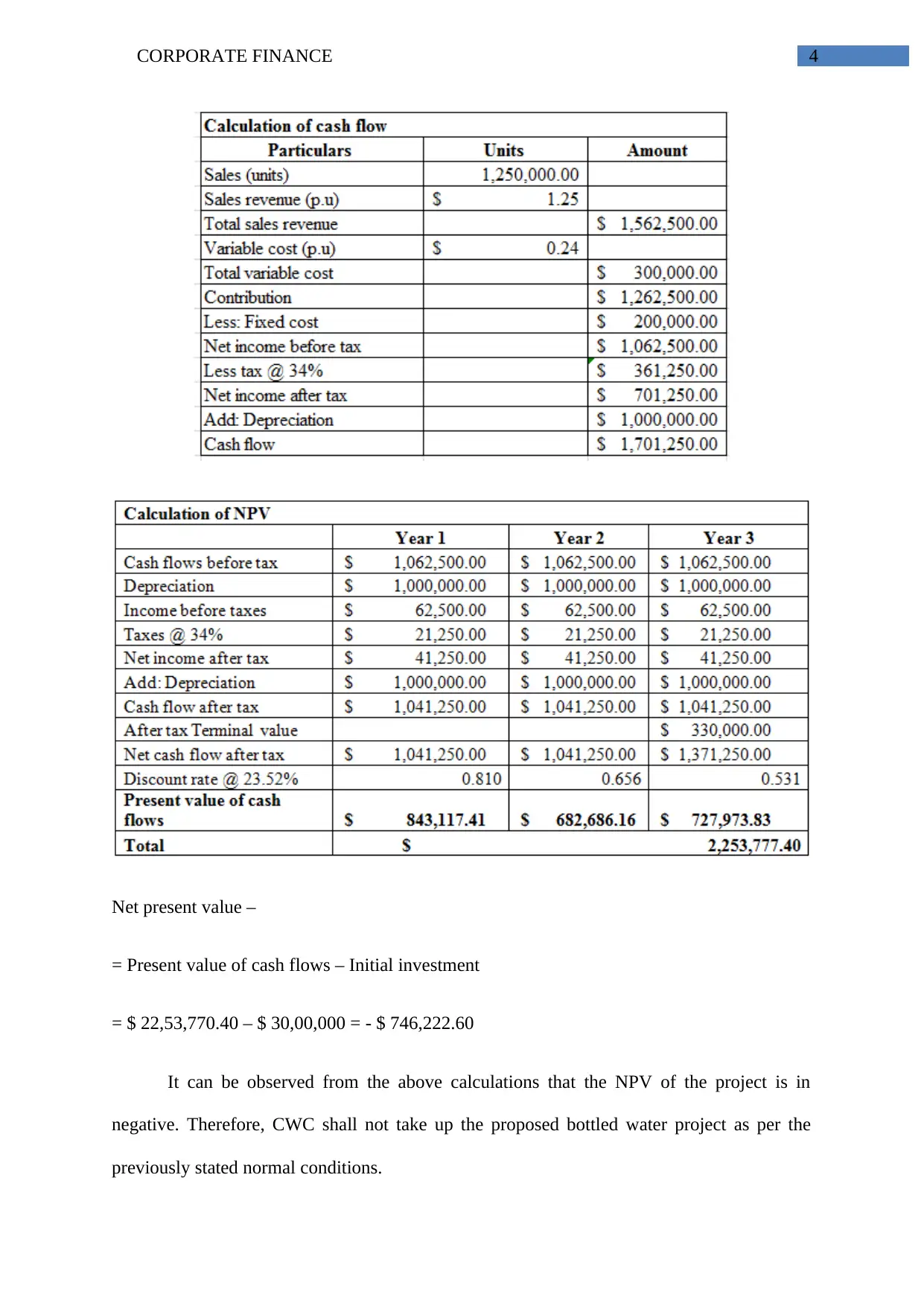
4CORPORATE FINANCE
Net present value –
= Present value of cash flows – Initial investment
= $ 22,53,770.40 – $ 30,00,000 = - $ 746,222.60
It can be observed from the above calculations that the NPV of the project is in
negative. Therefore, CWC shall not take up the proposed bottled water project as per the
previously stated normal conditions.
Net present value –
= Present value of cash flows – Initial investment
= $ 22,53,770.40 – $ 30,00,000 = - $ 746,222.60
It can be observed from the above calculations that the NPV of the project is in
negative. Therefore, CWC shall not take up the proposed bottled water project as per the
previously stated normal conditions.
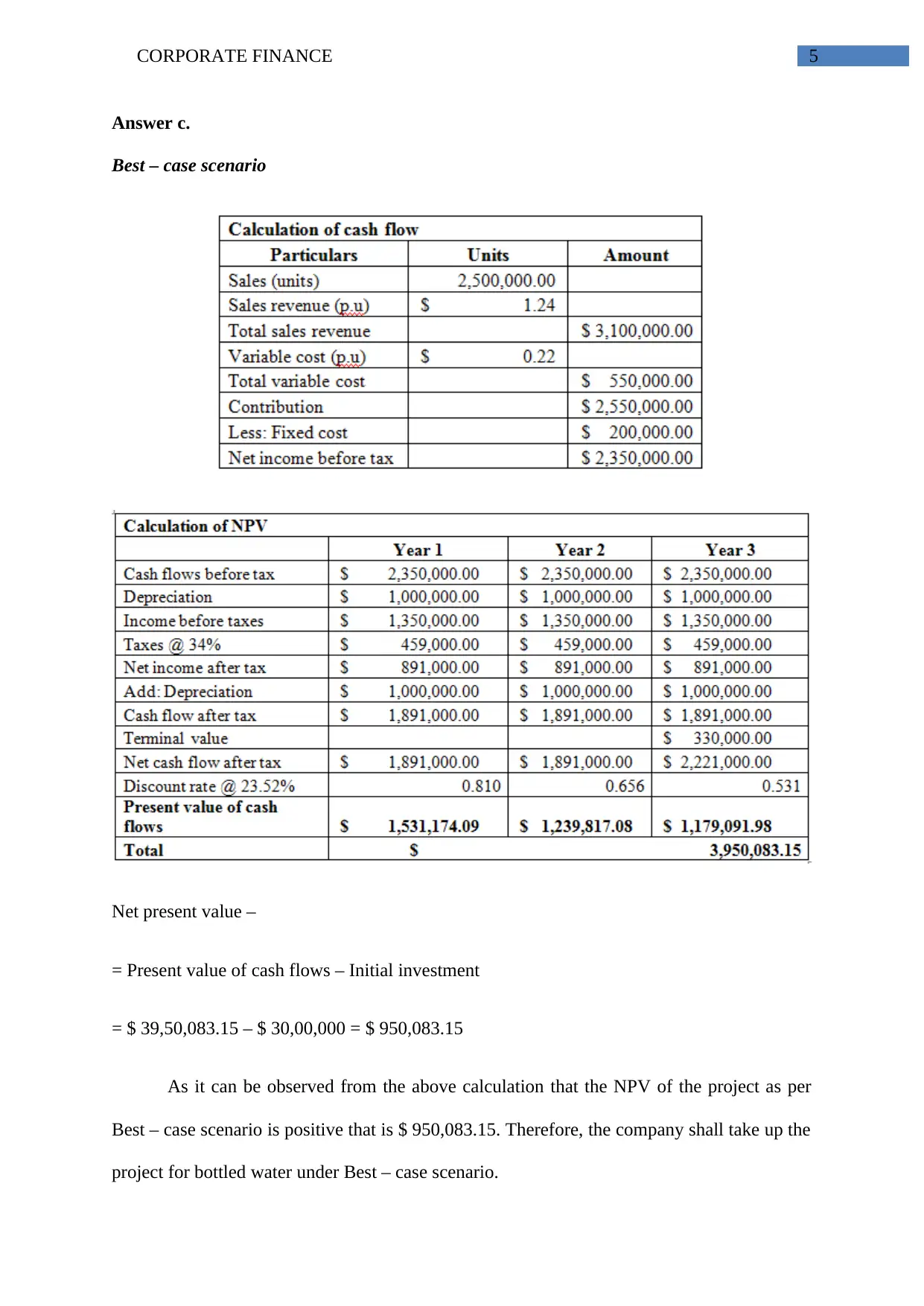
5CORPORATE FINANCE
Answer c.
Best – case scenario
Net present value –
= Present value of cash flows – Initial investment
= $ 39,50,083.15 – $ 30,00,000 = $ 950,083.15
As it can be observed from the above calculation that the NPV of the project as per
Best – case scenario is positive that is $ 950,083.15. Therefore, the company shall take up the
project for bottled water under Best – case scenario.
Answer c.
Best – case scenario
Net present value –
= Present value of cash flows – Initial investment
= $ 39,50,083.15 – $ 30,00,000 = $ 950,083.15
As it can be observed from the above calculation that the NPV of the project as per
Best – case scenario is positive that is $ 950,083.15. Therefore, the company shall take up the
project for bottled water under Best – case scenario.
⊘ This is a preview!⊘
Do you want full access?
Subscribe today to unlock all pages.

Trusted by 1+ million students worldwide
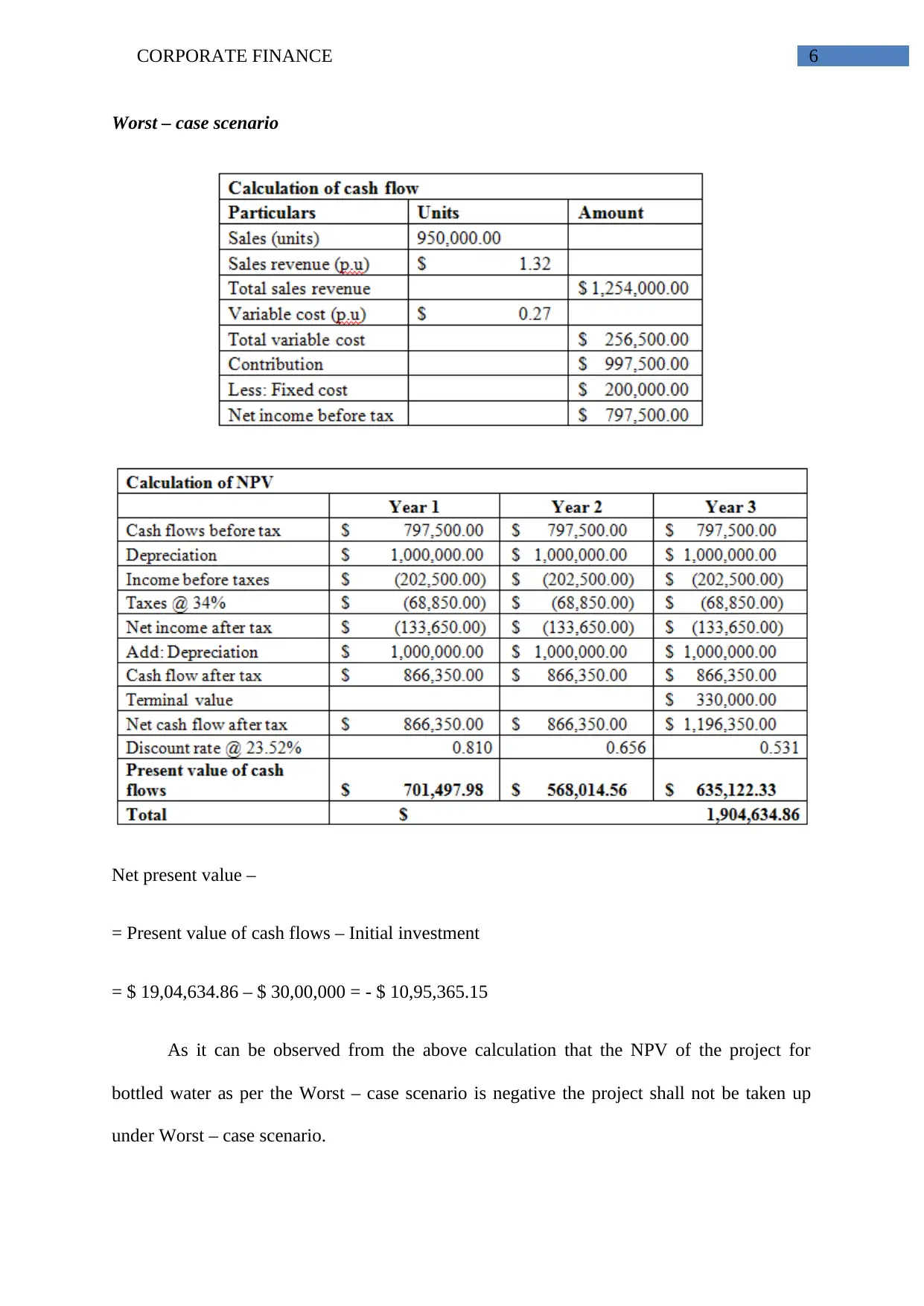
6CORPORATE FINANCE
Worst – case scenario
Net present value –
= Present value of cash flows – Initial investment
= $ 19,04,634.86 – $ 30,00,000 = - $ 10,95,365.15
As it can be observed from the above calculation that the NPV of the project for
bottled water as per the Worst – case scenario is negative the project shall not be taken up
under Worst – case scenario.
Worst – case scenario
Net present value –
= Present value of cash flows – Initial investment
= $ 19,04,634.86 – $ 30,00,000 = - $ 10,95,365.15
As it can be observed from the above calculation that the NPV of the project for
bottled water as per the Worst – case scenario is negative the project shall not be taken up
under Worst – case scenario.
Paraphrase This Document
Need a fresh take? Get an instant paraphrase of this document with our AI Paraphraser
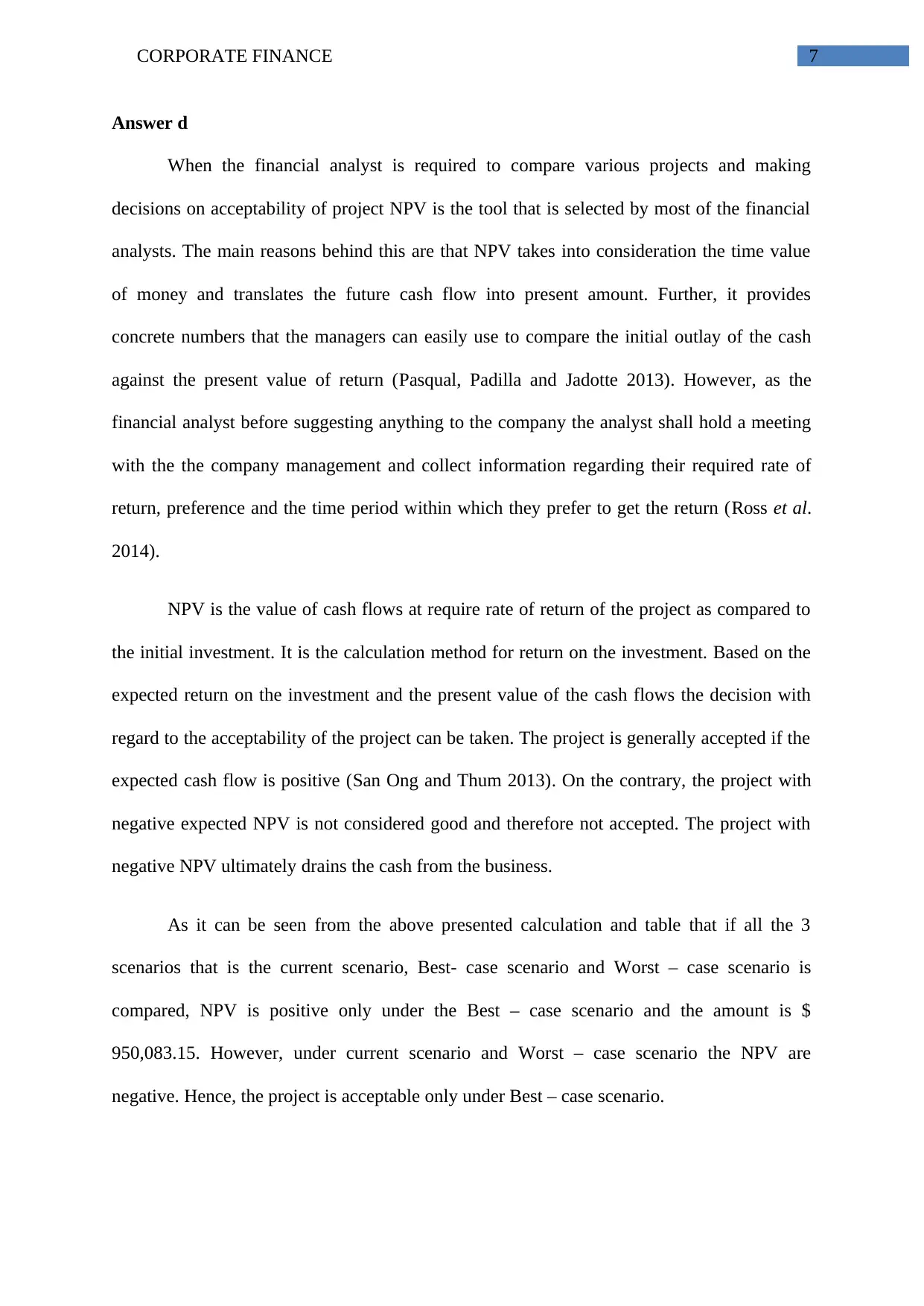
7CORPORATE FINANCE
Answer d
When the financial analyst is required to compare various projects and making
decisions on acceptability of project NPV is the tool that is selected by most of the financial
analysts. The main reasons behind this are that NPV takes into consideration the time value
of money and translates the future cash flow into present amount. Further, it provides
concrete numbers that the managers can easily use to compare the initial outlay of the cash
against the present value of return (Pasqual, Padilla and Jadotte 2013). However, as the
financial analyst before suggesting anything to the company the analyst shall hold a meeting
with the the company management and collect information regarding their required rate of
return, preference and the time period within which they prefer to get the return (Ross et al.
2014).
NPV is the value of cash flows at require rate of return of the project as compared to
the initial investment. It is the calculation method for return on the investment. Based on the
expected return on the investment and the present value of the cash flows the decision with
regard to the acceptability of the project can be taken. The project is generally accepted if the
expected cash flow is positive (San Ong and Thum 2013). On the contrary, the project with
negative expected NPV is not considered good and therefore not accepted. The project with
negative NPV ultimately drains the cash from the business.
As it can be seen from the above presented calculation and table that if all the 3
scenarios that is the current scenario, Best- case scenario and Worst – case scenario is
compared, NPV is positive only under the Best – case scenario and the amount is $
950,083.15. However, under current scenario and Worst – case scenario the NPV are
negative. Hence, the project is acceptable only under Best – case scenario.
Answer d
When the financial analyst is required to compare various projects and making
decisions on acceptability of project NPV is the tool that is selected by most of the financial
analysts. The main reasons behind this are that NPV takes into consideration the time value
of money and translates the future cash flow into present amount. Further, it provides
concrete numbers that the managers can easily use to compare the initial outlay of the cash
against the present value of return (Pasqual, Padilla and Jadotte 2013). However, as the
financial analyst before suggesting anything to the company the analyst shall hold a meeting
with the the company management and collect information regarding their required rate of
return, preference and the time period within which they prefer to get the return (Ross et al.
2014).
NPV is the value of cash flows at require rate of return of the project as compared to
the initial investment. It is the calculation method for return on the investment. Based on the
expected return on the investment and the present value of the cash flows the decision with
regard to the acceptability of the project can be taken. The project is generally accepted if the
expected cash flow is positive (San Ong and Thum 2013). On the contrary, the project with
negative expected NPV is not considered good and therefore not accepted. The project with
negative NPV ultimately drains the cash from the business.
As it can be seen from the above presented calculation and table that if all the 3
scenarios that is the current scenario, Best- case scenario and Worst – case scenario is
compared, NPV is positive only under the Best – case scenario and the amount is $
950,083.15. However, under current scenario and Worst – case scenario the NPV are
negative. Hence, the project is acceptable only under Best – case scenario.
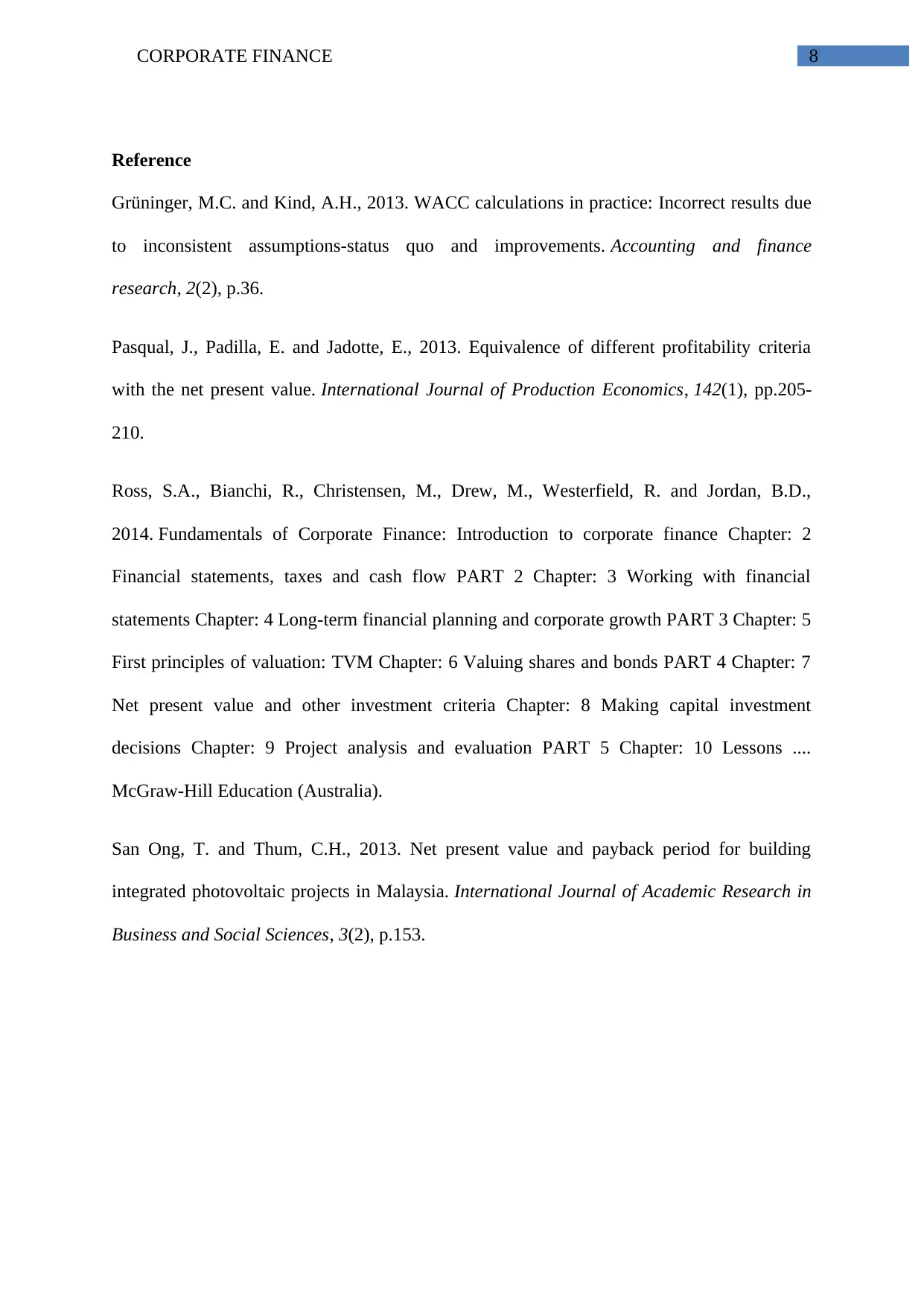
8CORPORATE FINANCE
Reference
Grüninger, M.C. and Kind, A.H., 2013. WACC calculations in practice: Incorrect results due
to inconsistent assumptions-status quo and improvements. Accounting and finance
research, 2(2), p.36.
Pasqual, J., Padilla, E. and Jadotte, E., 2013. Equivalence of different profitability criteria
with the net present value. International Journal of Production Economics, 142(1), pp.205-
210.
Ross, S.A., Bianchi, R., Christensen, M., Drew, M., Westerfield, R. and Jordan, B.D.,
2014. Fundamentals of Corporate Finance: Introduction to corporate finance Chapter: 2
Financial statements, taxes and cash flow PART 2 Chapter: 3 Working with financial
statements Chapter: 4 Long-term financial planning and corporate growth PART 3 Chapter: 5
First principles of valuation: TVM Chapter: 6 Valuing shares and bonds PART 4 Chapter: 7
Net present value and other investment criteria Chapter: 8 Making capital investment
decisions Chapter: 9 Project analysis and evaluation PART 5 Chapter: 10 Lessons ....
McGraw-Hill Education (Australia).
San Ong, T. and Thum, C.H., 2013. Net present value and payback period for building
integrated photovoltaic projects in Malaysia. International Journal of Academic Research in
Business and Social Sciences, 3(2), p.153.
Reference
Grüninger, M.C. and Kind, A.H., 2013. WACC calculations in practice: Incorrect results due
to inconsistent assumptions-status quo and improvements. Accounting and finance
research, 2(2), p.36.
Pasqual, J., Padilla, E. and Jadotte, E., 2013. Equivalence of different profitability criteria
with the net present value. International Journal of Production Economics, 142(1), pp.205-
210.
Ross, S.A., Bianchi, R., Christensen, M., Drew, M., Westerfield, R. and Jordan, B.D.,
2014. Fundamentals of Corporate Finance: Introduction to corporate finance Chapter: 2
Financial statements, taxes and cash flow PART 2 Chapter: 3 Working with financial
statements Chapter: 4 Long-term financial planning and corporate growth PART 3 Chapter: 5
First principles of valuation: TVM Chapter: 6 Valuing shares and bonds PART 4 Chapter: 7
Net present value and other investment criteria Chapter: 8 Making capital investment
decisions Chapter: 9 Project analysis and evaluation PART 5 Chapter: 10 Lessons ....
McGraw-Hill Education (Australia).
San Ong, T. and Thum, C.H., 2013. Net present value and payback period for building
integrated photovoltaic projects in Malaysia. International Journal of Academic Research in
Business and Social Sciences, 3(2), p.153.
⊘ This is a preview!⊘
Do you want full access?
Subscribe today to unlock all pages.

Trusted by 1+ million students worldwide
1 out of 9
Related Documents
Your All-in-One AI-Powered Toolkit for Academic Success.
+13062052269
info@desklib.com
Available 24*7 on WhatsApp / Email
![[object Object]](/_next/static/media/star-bottom.7253800d.svg)
Unlock your academic potential
Copyright © 2020–2025 A2Z Services. All Rights Reserved. Developed and managed by ZUCOL.


